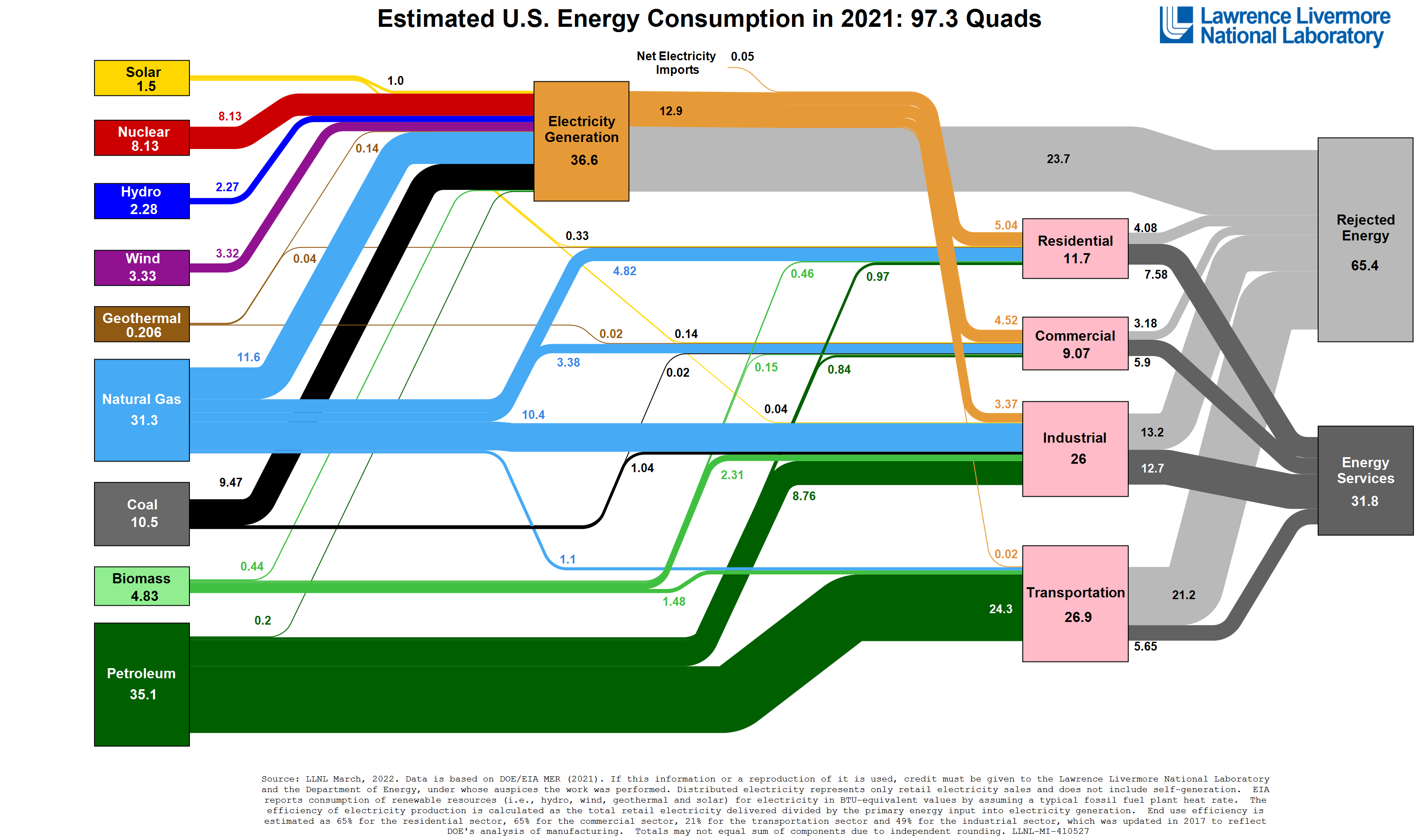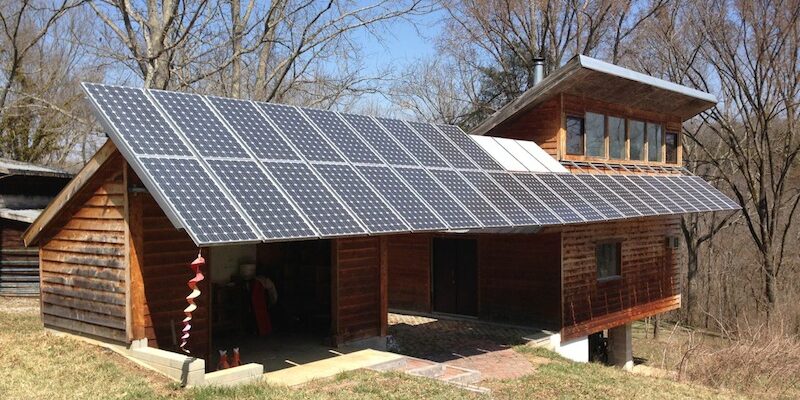The Meaning of Rejected Energy

I love the US energy flow charts published by the Lawrence Livermore National Lab each year. The chart for 2021 came out in April, and you can see it in its full glory above. (Right click to download the full version.) The most eye-catching part of the chart for many people is the rejected energy, shown in grey. A common reaction is: “Wow! We sure do waste a lot of energy. We need to be more efficient.” Let’s talk about that.
Burning fuels
The first thing to understand is that the great majority of that rejected energy comes from burning fuels. We burn petroleum, gas, coal, and biomass to get heat. Then we use that heat to do work. Sometimes the work moves a vehicle. Sometimes it runs industrial equipment. And sometimes it runs a turbine that generates electricity.
![A coal-fired power plant releases a lot of "waste heat" [photo by eutrophication&hypoxia, CC BY 2.0 Deed]](https://www.energyvanguard.com/wp-content/uploads/2022/07/coal-fired-power-plant-rejected-energy.jpg)
The limit of heat engine efficiency
The thing about heat engines, though, is that there’s no way to convert all of the heat energy into usable work. There will always be heat left over. That’s what makes up the bulk of that rejected energy you see above.

As it turns out, we’ve known this limitation for nearly 200 years. A French kid named Sadi Carnot figured out that there’s a limit on the efficiency of heat engines. He discovered the thermodynamic cycle that yields the maximum efficiency of a heat engine. His work is so important in thermodynamics that his maximum theoretical efficiency is called the Carnot efficiency.
In addition, he determined that the efficiency limit depends on only one factor: the temperature difference between the hot and cool sides of the heat engine. The larger the spread between the hot and cool temperatures, the more efficient the heat engine will be.
For the temperatures used in conventional electricity generation plants, about two-thirds of the energy in the fuel turns into rejected energy. Combined-cycle gas turbine power plants can achieve higher temperatures and get efficiencies up to about 60 percent. Automobiles reject about three-fourths of the fuel’s energy.
Can we do better?
We can wring a bit more water out of the fuel combustion sponge, as with combined-cycle gas turbines. Another improvement used in some places is what’s called the combined heat and power (CHP) plant, or cogeneration. It’s just a power plant located close enough to buildings that can use the lower temperature waste heat.
When you can take advantage of combined heat and power, a good portion of the rejected energy is no longer rejected. Yay! You send it to a hospital or office building or some other nearby facility that will use that heat for space or water heating. Unfortunately, combined heat and power is rare because most of the big electricity power plants are sited in rural areas, far from potential users of that waste heat.
Efficiency isn’t the solution to rejected energy
As long as we keep burning fuels, there will be a significant amount of rejected energy. That’s the nature of heat engines. There’s only way to minimize that big grey block in the upper right part of the chart: Replace combustion with renewable energy.

One benefit of that shift would be that we also get rid of the pollution and the carbon emissions that come with combustion. The rejected energy from combustion generally makes things worse. The rejected energy from solar and wind just does what it was going to do anyway.
A few last words
First, the LLNL chart is called an energy flow chart, but it’s really not a comprehensive look at energy. It’s a look at fuels. The subject of energy is much bigger and includes a lot of stuff that the chart here doesn’t touch. Second, a heat engine, which turns a temperature difference into work, can operate in reverse. When it turns work into a temperature difference, we call it a refrigerator or a heat pump. Third, there’s a whole lot going on in that chart. Further, you can get a better understanding of the trends in our fuel use by looking at how they’ve changed over time. I did that in a previous article on why it makes sense to go all-electric.
And finally, when you see all that rejected energy in the chart, I hope you’ll realize we can’t eliminate it just by being more efficient. It’s an unavoidable byproduct of combustion and heat engines.
Allison A. Bailes III, PhD is a speaker, writer, building science consultant, and the founder of Energy Vanguard in Decatur, Georgia. He has a doctorate in physics and writes the Energy Vanguard Blog. He also has a book on building science coming out in the fall of 2022. You can follow him on Twitter at @EnergyVanguard.
Related Articles
The #1 Reason to Have an All-Electric Home
Building Science and the Laws of Thermodynamics, Part Zero (the first of four articles on these laws)
US Energy Flows — Inputs and Outputs 1995 to 2010
Comments are moderated. Your comment will not appear below until approved.
This Post Has 20 Comments
Comments are closed.

Thanks for the excellent breakdown on the graphic and rejected energy.
In addition to CHP, fuel cells are another approach to convert fuel directly into electricity + heat. The theoretical efficiency can even approach 80% if I remember correctly.
The holy grail would be a residential fuel cell unit that converts natural gas into electricity, while using the excess heat for space and water heating with a price tag less than $20k. The unit could even run all the time and use net-metering in a form of distributed power generation. I think a significant part of the technological challenge has been extracting hydrogen from the natural gas using inexpensive and reliable materials.
Justin: Yes, fuel cells can improve upon the efficiency of conventional heat engine technology. Fuel cells are starting to seem like fusion to me, though. It’s the technology of the future…and seems like it always will be.
The thing I find most dismaying about the LLNL chart is the percentage of wasted energy, especially in the electrical generation and transportation flows. The rest are closer to 50/50% – not good,, but not as terrible as the 2 largest wasters. It also shows that building science is really involved in a fairly miniscule amount of energy use so it’s no surprise that building energy usage reduction gets little attention.
It should have been comfort, quality of life and building life cycle cost reduction all along.
David: It’s not so much wasted energy as unusable energy. As long as we keep burning fuels, the rejected energy will be significant. The reason the other sectors aren’t as large is that they use more of the heat of combustion for heat needed on site. In homes, for example, gas furnaces reject 20% or less of the energy in the fuel (neglecting duct losses).
I’m disappointed that despite there being over 2 million plug-in EVs on US roads, electricity used for transportation remains a measly 0.2 quads…but I did some back of envelope math and it pencils out to maybe 0.1 quads for EVs. I guess the other 0.1 quads goes into electrified railroads and trolleys.
It took me awhile to figure out how 1.48 quads of biomass gets used in transportation – apparently that comes from ethanol and biodiesel.
Curt: One thing that might make you feel a little better about it is that the numbers look better for EVs powered by electricity that’s generated by solar or wind. Since the rejected energy for those sources is so low, each 0.1 Quad of solar or wind replaces about 0.5 Quad of petroleum.
Did you know that a big component of “renewables” in the USA is wood? Trees are cut down and reduced to wood pellets – all by fossil fuel powered machines – and that wood is burned in furnaces to power electricity generating turbines, with tons of rejected energy and carbon dioxide (wood is a hydrocarbon fuel). That’s a dirty little secret about “renewables” the Green New Deal folks don’t want you to know.
JDaveF: There’s no secret here. Biomass has been around a long time. And here’s what you seem to have missed: Few people who promote renewables don’t count biomass in that category. The primary renewables are solar and wind. They’re growing like crazy and produce very little rejected energy.
I would very much like to see numbers behind the claim of wood pellet power plants. A great deal of wood byproducts are burned within paper mills since the fuel itself is created by paper manufacturing processes and the mills have huge heat and power requirements – these are a great example of onsite combined heat and power. (Though not without other major environmental problems…)
Wood pellets are also a niche fuel for those who like wood or coal stoves in their homes but not the hassle of burning logs or dealing with coal…again, very much a niche product.
But wood pellet power plants on the grid at commercially meaningful outputs? Examples / numbers, please.
I love those Sankey charts, use them to do a lecture to my students, check out the link. “lessons from Livermore”
Great article, Lloyd! I hadn’t seen any of these charts for any country other than the US, nor the US chart from 1950. Thanks!
For those who maybe didn’t find Lloyd’s link, here it is:
https://www.treehugger.com/lessons-livermore-look-big-picture-figure-out-where-we-have-go-4858824
An interesting thing about the 1950 US chart is that in 1950 we wasted about 45% of generated energy (rejected), and 71 years later we wasted 67%. Now that’s progress.
Lloyd, in another article you wrote, “the upfront carbon emissions of certain insulating materials can be greater than all the energy they save.” Which insulating materials do you mean?
Thanks to Allison for discussing this!
A recent book “Electrify” by Saul Griffith, makes the case for electrifying everything and generating that electricity from renewable sources. Doing so would immediately reduce the amount of energy needed by the amount of the rejected energy. Essentially, we could halve our energy use without any reduction in energy use. Its a convincing case.
The essence of getting there is two fold. One is to never buy another fossil fuel anything and replacing those things with electric when their usable life is up. The other is to ramp up renewable generation to match this new demand.
https://www.amazon.com/Electrify-Optimists-Playbook-Energy-Future/dp/0262046237
I have always thought Griffith’s argument was inane. We don’t halve our energy use, because our use is the energy services, not the rejected energy. Use is not the same thing as consumption. The energy that we are actually using on the Sankey chart is 31.8 quads, and the rest is waste along the way. To make Griffith’s electrify everything fantasy work where we don’t have to give anything up because we are “saving” so much energy, we have to find another 16 quads of nukes, hydro, solar, and wind. Good luck with that. https://www.treehugger.com/can-we-fight-climate-change-by-just-electrifying-everything-5185685
I assume that Rejected Energy is heat transferred to the environment (from an AC condenser, furnace flue, etc.) and Energy Services is the energy that is directly used for heating or cooling in a building? If so, this is quite misleading since air conditioners must reject some heat to the environment due to the First Law of Thermodynamics. A more efficient AC rejects this heat at a temperature that is closer to the outdoor temperature, so this is not “waste” heat since it has very little thermodynamic value.
Another issue is that this diagram does not show that heat pumps take energy from the environment. Why is that not important? Should that not be subtracted from Rejected Heat?
I am assuming that this type of analysis assumes that the energy that goes out the flue of a gas furnace is Rejected Heat. If so, then a very high efficiency gas furnace (97% AFUE) has little Rejected Heat. From a thermodynamic point of view, this furnace has a good First Law efficiency but a lousy Second Law efficiency. Natural gas can be use to drive heat pumps with “efficiencies” greater than one and those systems are available today.
My point here is that this diagram is misleading in that it does not properly account for heat pump performance or distinguish between what Rejected Energy is waste heat vs. what is simply required by thermodynamic laws.
I always look forward to reading this LLNL chart, fascinating to study and contemplate. However, one has to be careful because energy flows are not CO2 flows, and they can be quite different. For example, the chart includes the waste energy from nuclear power plants in the rejected energy bucket, but that waste energy is essentially zero CO2. And CO2 generation from coal and oil combustion is much higher than that from natural gas.
Fortunately, LLNL now produces a CO2 flow chart: https://flowcharts.llnl.gov/commodities/carbon . This chart clearly shows that to get the most bang (CO2 reduction) for the buck (cost of solar+wind+storage) for the next several decades, replacing coal and oil should be the focus, not natural gas. In other words, the opportunity cost of electrifying high efficiency gas heating instead of coal-fired generation and oil-transportation is very, very high.
Thanks for the excellent, informative and well-written article. One question, is this sentence from the article true? “The rejected energy from solar and wind just does what it was going to do anyway.” I ask because solar panels are dark blue/black. Yet the average color of the earth (albedo) is much lighter – some form of admixture of sand, snow, greenery etc. Thus solar panels reflect less energy back into the sky. sure, if you are putting solar panels on black roofs, then it doesnt matter. But various countries are covering light sandy deserts with dark solar panels, cutting trees down on hillsides to cover them with solar panels, etc. thank you.
That’s the Freakecomonics argument that was shredded by the University of Chicago physics Dept(same school).
https://www.realclimate.org/index.php/archives/2009/10/an-open-letter-to-steve-levitt
I
thomas: I believe the argument you’re referring to is patrick ennis’s comment above about the excess heat captured by photovoltaics that would otherwise be reflected back into space. It looks like you didn’t hit the reply button there to have it nested, so I’m just making that clear here.
That’s a great article. Thanks for providing the link. The tl;dr from the article is that Prof. Pierrehumbert, a geophysicist at the University of Chicago, goes through some simple math to show that waste heat is insignificant to global warming. And not only is the rejected energy/waste heat from solar panels negligible, but so is the rejected energy/waste heat from coal-burning power plants. It’s all about the carbon emissions. So, yes, I agree that he did shred that argument.